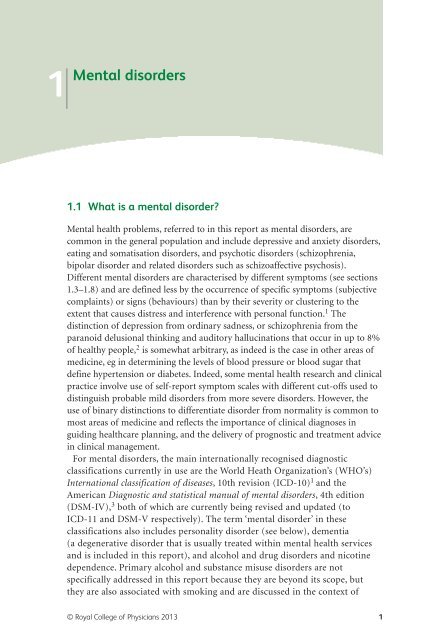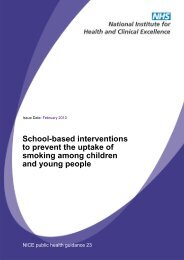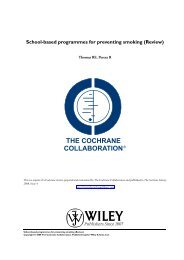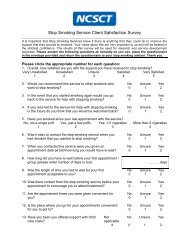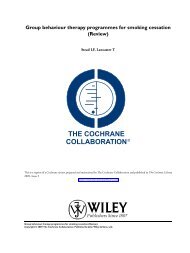Smoking and mental health - NCSCT
Smoking and mental health - NCSCT
Smoking and mental health - NCSCT
You also want an ePaper? Increase the reach of your titles
YUMPU automatically turns print PDFs into web optimized ePapers that Google loves.
1<br />
Mental disorders<br />
1.1 What is a <strong>mental</strong> disorder?<br />
Mental <strong>health</strong> problems, referred to in this report as <strong>mental</strong> disorders, are<br />
common in the general population <strong>and</strong> include depressive <strong>and</strong> anxiety disorders,<br />
eating <strong>and</strong> somatisation disorders, <strong>and</strong> psychotic disorders (schizophrenia,<br />
bipolar disorder <strong>and</strong> related disorders such as schizoaffective psychosis).<br />
Different <strong>mental</strong> disorders are characterised by different symptoms (see sections<br />
1.3–1.8) <strong>and</strong> are defined less by the occurrence of specific symptoms (subjective<br />
complaints) or signs (behaviours) than by their severity or clustering to the<br />
extent that causes distress <strong>and</strong> interference with personal function. 1 The<br />
distinction of depression from ordinary sadness, or schizophrenia from the<br />
paranoid delusional thinking <strong>and</strong> auditory hallucinations that occur in up to 8%<br />
of <strong>health</strong>y people, 2 is somewhat arbitrary, as indeed is the case in other areas of<br />
medicine, eg in determining the levels of blood pressure or blood sugar that<br />
define hypertension or diabetes. Indeed, some <strong>mental</strong> <strong>health</strong> research <strong>and</strong> clinical<br />
practice involve use of self-report symptom scales with different cut-offs used to<br />
distinguish probable mild disorders from more severe disorders. However, the<br />
use of binary distinctions to differentiate disorder from normality is common to<br />
most areas of medicine <strong>and</strong> reflects the importance of clinical diagnoses in<br />
guiding <strong>health</strong>care planning, <strong>and</strong> the delivery of prognostic <strong>and</strong> treatment advice<br />
in clinical management.<br />
For <strong>mental</strong> disorders, the main internationally recognised diagnostic<br />
classifications currently in use are the World Heath Organization’s (WHO’s)<br />
International classification of diseases, 10th revision (ICD-10) 1 <strong>and</strong> the<br />
American Diagnostic <strong>and</strong> statistical manual of <strong>mental</strong> disorders, 4th edition<br />
(DSM-IV), 3 both of which are currently being revised <strong>and</strong> updated (to<br />
ICD-11 <strong>and</strong> DSM-V respectively). The term ‘<strong>mental</strong> disorder’ in these<br />
classifications also includes personality disorder (see below), dementia<br />
(a degenerative disorder that is usually treated within <strong>mental</strong> <strong>health</strong> services<br />
<strong>and</strong> is included in this report), <strong>and</strong> alcohol <strong>and</strong> drug disorders <strong>and</strong> nicotine<br />
dependence. Primary alcohol <strong>and</strong> substance misuse disorders are not<br />
specifically addressed in this report because they are beyond its scope, but<br />
they are also associated with smoking <strong>and</strong> are discussed in the context of<br />
© Royal College of Physicians 2013 1


